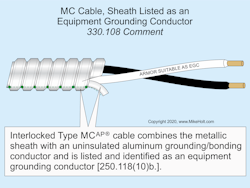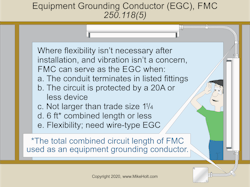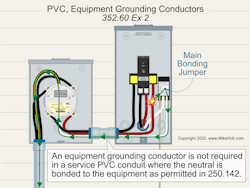The Differences Between Grounding and Bonding ― Part 8 of 12
Courtesy of www.MikeHolt.com.
This article is the eighth in a 12-part series on the differences between grounding and bonding.
Chapter 3 in the National Electrical Code (NEC) covers conductors [Art. 310]; cabinets and meter socket enclosures [Art. 312]; and boxes, conduit bodies, and handhole enclosures [Art. 314]. The remaining Articles are specific to individual wiring methods, such as cables [Art. 320 through Art. 340], raceways [Art. 342 through Art. 390], and cable tray [Art. 392].
Conductors
Article 300 contains the general requirements for NEC wiring methods. Article 300 does not apply to signaling and communications systems, as these system requirements are covered in Chapter 7. In addition, Art. 300 doesn’t apply to integral parts of equipment unless specifically referenced [Sec. 300.1(B)].
You must install single conductors in a Chapter 3 wiring method [Sec. 300.3(A)]. All conductors of a circuit, including the neutral and equipment grounding conductors (EGCs), must be in the same raceway, cable, trench, cord, or cable tray, except as permitted by Sec. 300.3(B)(1) through (B)(4) [Sec. 300.3(B)].
Metal raceways, cable armor, and other metal enclosures must be metallically joined into a continuous electrical conductor to provide effective electrical continuity [Sec. 300.10 and Sec. 250.4(A)(3)]. This establishes the effective ground-fault current path necessary for the circuit overcurrent protective device to operate in response to a ground fault [Sec. 250.4(A)(5)].
Exception No. 1: Short lengths of metal raceways to support or protect cables don’t have to be electrically continuous or connect to an EGC [Sec. 250.86 Exception No. 2 and Sec. 300.10 Exception No. 1].
Armored cable (Type AC)
AC cable [Art. 320] is an assembly of insulated conductors individually wrapped in wax paper (jute) and contained within a flexible spiral metal sheath. The metal sheath of Type AC cable provides an adequate path for fault current and can serve as an EGC [Sec. 250.118(8)].
Metal-clad cable (Type MC)
Type MC cable [Art. 330] encloses insulated conductors in a metal sheath of either corrugated or smooth copper or aluminum tubing, or in spiral interlocked steel or aluminum.
A variation of this cable combines the metallic sheath with an uninsulated aluminum grounding/bonding conductor and is listed and identified as an EGC [Sec. 250.118(10)b] (Fig. 1). But traditional interlocked MC cable cannot serve as an EGC; therefore, it must contain an EGC of the wire type per Sec. 250.118(1) and comply with Sec. 250.118(10)(a) and Sec. 250.122 [Sec. 330.108].
Nonmetallic-sheathed cable (Type NM)
NM cable [Art. 334] provides minimal physical protection for the conductors, so the installation restrictions are stringent. Its low cost and relative ease of installation make it a common wiring method for residential and commercial branch circuits. NM cable encloses two or more insulated conductors within a nonmetallic jacket [Sec. 334.2]. It must have an EGC of the wire type [Sec. 334.108].
Flexible metal conduit (Type FMC)
FMC (“flex”) [Art. 348] is a raceway of circular cross-section made of helically wound, formed, interlocked metal strips, listed for the installation of electrical conductors [Sec. 348.2].
If flexibility is necessary to minimize the transmission of vibration from equipment or to allow for equipment that requires movement, an EGC of the wire type must be installed with the circuit conductors per Sec. 250.118(5)(e) [Sec. 348.60].
If flexibility is unnecessary, then the metal armor of FMC can serve as an EGC if the circuit conductors contained in the raceway are protected by an overcurrent protective device rated 20A or less, and the combined length of the raceway in the same ground-fault return path does not exceed 6 ft [Sec. 250.118(5)] (Fig. 2).
The equipment bonding jumper can be installed inside or outside the FMC. Where installed outside the FMC, the equipment bonding jumper can’t exceed 6 ft and must be routed with the FMC per Sec. 250.102(E)(2).
Liquidtight flexible metal conduit (Type LFMC)
LFMC (Art. 350) is a flexible raceway of circular cross-section, having an outer liquidtight, nonmetallic, sunlight-resistant jacket over an inner flexible metal core, with associated connectors and fittings, listed for the installation of electrical conductors [Sec. 350.2]. LFMC is commonly used for the same reasons as FMC, except you also want protection from liquids and some corrosive effects.
If flexibility is necessary to minimize the transmission of vibration from equipment, or to provide flexibility for equipment that requires movement after installation, an EGC of the wire type must be installed with the circuit conductors per Sec. 250.118(6).
If flexibility is not necessary after installation and vibration is not a concern, then the metal armor of LFMC can serve as an EGC if the circuit conductors contained in the raceway are protected by an overcurrent protective device rated 20A or less, and the combined length of the raceway in the same ground-fault return path does not exceed 6 ft per Sec. 250.118(6).
Rigid polyvinyl chloride conduit (Type PVC)
PVC (Art. 352) is a rigid nonmetallic, circular raceway with integral or associated couplings, listed for use with electrical conductors [Sec. 352.2]. PVC provides many of the advantages of rigid metal conduit (RMC) while allowing installation in wet or corrosive areas. It is inexpensive, easily installed, lightweight, easily cut and glued, and relatively strong. However, PVC is brittle when cold and sags when hot.
If equipment must connect to an EGC, then a separate EGC of the wire type must be installed inside the raceway [Sec. 352.60]. Note that this provision applies to all nonmetallic raceways.
Section 352.60 Exception No. 2: An EGC is not required in a service PVC conduit where the neutral is bonded to the equipment as permitted in Sec. 250.142 (Fig. 3).
Liquidtight flexible nonmetallic conduit (Type LFNC)
LFNC (Art. 356) is a listed, circular raceway with an outer liquidtight, nonmetallic, sunlight-resistant jacket over an inner flexible core with associated couplings, connectors, and fittings [Sec. 356.2]. An EGC is not required in a nonmetallic raceway supplying nonmetallic equipment because there is nothing in the nonmetallic box that requires a connection to an EGC.
Electrical metallic tubing (Type EMT)
EMT (Art. 358) is a lightweight, unthreaded thin-wall circular metallic raceway. It is relatively easy to bend, cut, and ream [Sec. 358.2]. When joined with listed fittings and enclosures as a complete system, it reliably provides physical protection for conductors and an effective ground-fault current path.
Because EMT is not threaded, all connectors and couplings are of the threadless type (either set-screw or compression). These provide for quick, easy, and inexpensive installations as compared to other metallic raceway systems.
Couplings and connectors must be made up tight to maintain an effective ground-fault current path to safely conduct fault current per Sec. 250.4(A)(5), Sec. 250.96(A), and Sec. 300.10 [Sec. 358.42]. EMT can serve as an EGC [Sec. 250.118(4)].
All Chapter 3 conduits have the word “conduit” in the name. EMT is tubing, not conduit.
Surface metal raceways
Using a surface metal raceway (Art. 386) is a common method of adding a raceway when exposed traditional raceway systems are unacceptable and concealing the raceway is economically infeasible. They come in several colors and are available with colored or real wood inserts designed to make them look like molding rather than raceways.
They are available in different shapes and sizes. They can be mounted on walls, ceilings, or floors. Some have separate compartments that permit separating power and lighting conductors from low-voltage or limited-energy conductors or cables (control, signaling, and communications cables and conductors) [Sec. 386.70].
A surface metal raceway that is listed for grounding is suitable as an EGC per Sec. 250.118(14). To serve this purpose, fittings must be mechanically and electrically joined in a manner that does not subject the conductors to abrasion. Surface metal raceways that allow a transition to another wiring method, such as knockouts for connecting raceways, must have a means for the termination of an EGC.
Cable trays
A cable tray (Art. 392) is not a raceway, it is a support system for cables and raceways. Cable tray systems include ladder, ventilated trough, ventilated channel, solid bottom, and other similar structures. They are manufactured in many forms — from a simple hanger or wire mesh to a substantial rigid, steel support system. Cable trays are designed and manufactured to support specific wiring methods, as identified in Sec. 392.10(A).
Metal cable trays can be used as EGCs where the conditions of Sec. 392.60 are met. For example, the trays and fittings are identified as an EGC.
Needed for bonding
Chapter 3 provides specific installation requirements for conductors, cables, boxes, raceways, and fittings. You must get these right to create an effective equipment grounding (bonding) system.
Sidebar: Boxes, Conduit Bodies, and Handhole Enclosures
Article 314 contains the installation requirements for boxes, conduit bodies, and handhole enclosures.
You can use nonmetallic boxes only with nonmetallic cables and raceways [Sec. 314.3] unless the raceways and cables are bonded together in the nonmetallic box. You must connect metal boxes to an EGC per Sec. 250.148 [Sec. 314.4].
Each box must have a cover, faceplate, fixture canopy, or similar device [Sec. 314.25]. Metal covers must be connected to an EGC per Sec. 250.110.
Metal covers and exposed conductive surfaces of handhole enclosures containing branch-circuit and feeder conductors must be bonded to an EGC sized per Sec. 250.96(A).
These materials are provided to us by Mike Holt Enterprises in Leesburg, Fla. To view Code training materials offered by this company, visit www.mikeholt.com/code.








